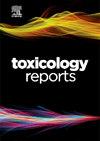0.3 % DMSO对果蝇模型的神经元效应及0.3 % DMSO与UCH-L1损失函数的协同作用。
Q1 Environmental Science
引用次数: 0
摘要
二甲基亚砜(DMSO)是一种极性非质子溶剂,广泛应用于生物和医学研究,并作为药物治疗的载体。DMSO浓度为0.1 %至0.5 %,特别是0.3 %,在测试化合物对活细胞、组织(包括神经细胞)的影响时,通常用作溶解化合物的溶剂。然而,关于二甲基亚砜对神经系统影响的科学数据有限。本文采用实验数据研究了浓度为0.3 %的DMSO对黑胃果蝇神经细胞的影响。我们发现0.3 % DMSO浓度对活性区和谷氨酸受体有影响。值得注意的是,本研究还揭示了0.3 % DMSO与duh(泛素羧基末端水解酶-L1, UCH-L1的同源物)的损失函数的协同作用。这种组合导致了更严重的突触结构异常,特别是神经肌肉连接处(NMJ)钮扣数量的异常。此外,0.3 % DMSO降低了正常和遗传缺陷苍蝇模型间接飞行肌中泛素化蛋白聚集体的数量。综上所述,本研究的数据表明,0.3 % DMSO导致果蝇间接飞行肌突触结构形态的异常,并减少了泛素化蛋白的数量。这项研究的数据为DMSO对神经系统的影响提供了新的证据。值得注意的是,本研究揭示了DMSO在低浓度下对神经元细胞的影响,它被广泛用作药理溶剂。本文章由计算机程序翻译,如有差异,请以英文原文为准。
Neuronal effect of 0.3 % DMSO and the synergism between 0.3 % DMSO and loss function of UCH-L1 on Drosophila melanogaster model
Dimethyl sulfoxide (DMSO) is a polar aprotic solvent which is widely used in biological and medical studies and as a vehicle for pharmacological therapy. DMSO from 0.1 % to 0.5 %, particularly 0.3 % is commonly used as solvent to dissolve compounds when testing their effect on living cell, tissues including nerve cell. However, scientific data on the effects of DMSO on nervous system is limited. Here, we present our data of case study on investigation the effects of DMSO at 0.3 % concentration on nerve cell of Drosophila melanogaster model. We found that 0.3 % DMSO concentration had affected on the active zone and glutamate receptor. Notably, this study also revealed the synergistic effect of 0.3 % DMSO and loss function of dUCH (the homolog of Ubiquitin Carboxyl terminal Hydrolase -L1, UCH-L1 in D. melanogaster). This combination caused more serious abnormalities in synapse structure, particularly number of boutons on Neuromuscular Junction, NMJ. Furthermore, 0.3 % DMSO reduced the amount of ubiquitinylated protein aggregates in the indirect flight muscle of both normal and genectic defect fly model. Taken together, data in this sytudy indicated that 0.3 % DMSO caused the aberrant morphology of the synaptic structure and decreased the number of ubiquitinylated proteins in the indirect flight muscle of Drosophila. The data from the study contributed new evidence of the effects of DMSO on the nervous system. Signigicantly, this study revealed that DMSO affected on neuron cell at low concentration which widely used as pharmacological solvent.
求助全文
通过发布文献求助,成功后即可免费获取论文全文。
去求助
来源期刊

Toxicology Reports
Environmental Science-Health, Toxicology and Mutagenesis
CiteScore
7.60
自引率
0.00%
发文量
228
审稿时长
11 weeks
 求助内容:
求助内容: 应助结果提醒方式:
应助结果提醒方式:


